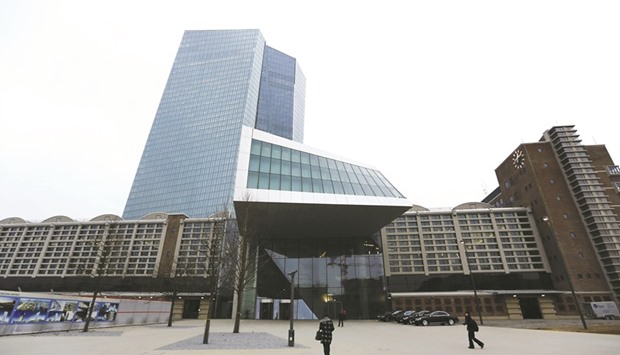European Central Bank (ECB) officials are beginning to wonder how they’re going to tell the world when the end of the stimulus era is in sight.
A proposal by Executive Board member Yves Mersch to review the ECB’s guidance on future actions has focused policy makers’ minds on the challenge of mapping an exit from quantitative easing and negative interest rates.
While the strengthening euro-area economy might justify a change in language, a bigger concern is that it would lead to tighter market conditions that undermine current measures, according to Eurosystem officials familiar with the matter.
That means the moment probably hasn’t yet arrived for such a revision to the Governing Council’s official statement, the people said, asking not to be named because the deliberations are confidential. An ECB spokesman declined to comment.
The Frankfurt-based central bank is in a complex predicament, having to justify why the euro area still needs unprecedented stimulus even with headline inflation near its goal and the economy continuing to expand.
That situation will be thrown into sharper relief by the summer if the recovery is still looking robust after elections in France and the Netherlands and as US economic policy under President Donald Trump – a key concern for officials – takes shape.
The ECB’s current position, decided at the Governing Council’s six-weekly policy meetings and announced by President Mario Draghi at his subsequent press conference, is that interest rates will stay at present or lower levels for an extended period, and until well after its €2.28tn ($2.4tn) bond-buying program has ended.
Mersch suggested this month that by insisting rates can go lower, knowing that the effects could be unpredictable, the ECB may damage its credibility. Strengthening his tone after airing a similar idea in November, he said there should be “no delay in making the necessary, gradual adjustments to our communication.”
The risk for the ECB is that however justifiable that stance might be given incoming data, it would feed the idea that a turning point for stimulus is near. With euro-area inflation now at 1.8% – near the goal of just under 2%, although largely due to energy prices – voices calling for a discussion on a change in stance are growing louder.
Mersch’s colleague Sabine Lautenschlaeger said on Sunday that she’s “delighted” about the pickup in consumer-price growth and wants “to return to normalisation as soon as possible.”
Even so, she also said in her interview with Deutschlandfunk that it’s important to be certain inflation really has returned. The rest of the Governing Council doesn’t look ready to change tack just yet either.
Bostjan Jazbec, the head of Slovenia’s central bank, said in a Bloomberg interview that the idea of scaling back stimulus is still “hypothetical” and any discussions are some way off.
Austria’s Ewald Nowotny told Der Standard that there is “no reason to depart from the current stance” of monetary policy. Referring to Mersch’s proposal, Ireland’s Philip Lane told the Wall Street Journal that it’s unlikely rates will be cut again, but retaining the option to do so signals a readiness to act and “I don’t see why we would necessarily give that up.” The ECB has previously walked back from commitments on rates.
When the deposit rate was cut below zero for the first time in June 2014, Draghi said that “for all practical purposes” the lower bound had been reached. Cutting rates again just three months later, he said it was a “technical adjustment.” The deposit rate has since dropped twice more and stands at minus 0.4%.
The Governing Council may eventually decide that it can find a way to change its language without spooking investors. A test of that came in December, when it agreed to reduce the pace of QE. By only starting in April and in conjunction with a 9-month extension of the programme, it convinced most commentators that this wasn’t the start of tapering purchases to zero.
This month’s inflation reading will be published on February 28, when it may accelerate again.
The next monetary-policy meeting will be held on March 9, when fresh economic projections may show that the outlook for euro-area inflation has picked up. If so, Draghi may find it gets even harder to keep demands for a communication change at bay.

People walk in front of the European Central Bank headquarters in Frankfurt. The ECB is in a complex predicament, having to justify why the euro area still needs unprecedented stimulus even with headline inflation near its goal and the economy continuing to expand.


